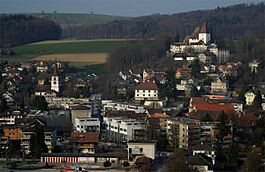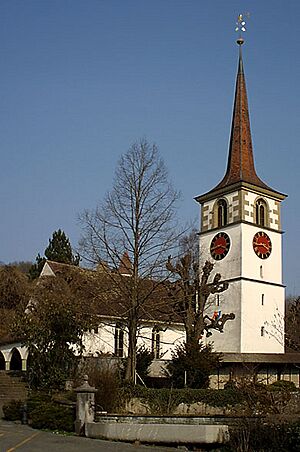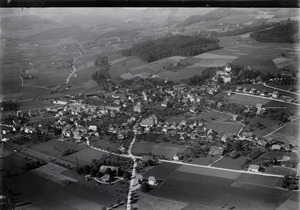Worb facts for kids
Quick facts for kids
Worb
|
||
|---|---|---|
 |
||
|
||
| Country | Switzerland | |
| Canton | Bern | |
| District | Bern-Mittelland | |
| Area | ||
| • Total | 21.08 km2 (8.14 sq mi) | |
| Elevation | 585 m (1,919 ft) | |
| Population
(Dec 2020 )
|
||
| • Total | 11,621 | |
| • Density | 551.28/km2 (1,427.8/sq mi) | |
| Postal code |
3076
|
|
| Surrounded by | Allmendingen, Biglen, Muri bei Bern, Rubigen, Schlosswil, Trimstein, Vechigen, Walkringen | |
| Twin towns | Edelény (Hungary) | |
Worb is a town, also called a municipality, in the Bern-Mittelland area in the canton of Bern in Switzerland. It's a place where many people live and work, and it has a long history.
Contents
History of Worb
Worb was first mentioned in old writings around the years 1130-1146. It was called Worw back then.
Early Settlements and Roman Times
People have lived in the Worb area for a very long time. Scientists have found tools and items from the neolithic (New Stone Age) period. There are also ancient grave mounds from the Hallstatt culture in the Buchliwald forest. A cemetery from the La Tene culture has been found at Rohrmoos-Stockeren.
Later, during the Roman times (around the 2nd and 3rd centuries), a Roman farm and a Roman grave were discovered here. In the Early Middle Ages, there was a small village with a cemetery at Vielbringen.
Worb Castle and Its Rulers
The first noble family, the Freiherr de Worvo, was mentioned in 1127. This was even before the village itself appeared in records. By the late 1200s, the Freiherr von Kien family took over Worb. They owned the village, its lands, and Worb Castle.
This family ruled the Worb Herrschaft (a type of territory) until 1336. Then, they became citizens of Bern, and Worb came under Bern's control. Over many centuries, different noble families from Bern ruled Worb. They sometimes divided the land and then put it back together.
The lord of Worb had the right to make local laws and hold a low court. Serious crimes were judged in Konolfingen. In 1469, there was a disagreement about who had power between Bern's court representative and Worb's local officer, called a bailiff. It took two years to sort out their rights and jurisdiction (legal power).
Building and Changing Worb Castle
The main part of Worb Castle was built before 1130. It first had a strong tower (a keep), a large hall, and a house for knights. The castle was fixed up in 1469 and again in 1594. In 1643, a new living area was added.
In 1734, a new, fancy manor house was built near the old castle. This new estate was called Neuworb, or sometimes the Neuschloss (New Castle). In 1846, both the old and new castles were bought by the Goumoëns-Sinner family. Later, in 1964, the Seelhofer family bought the old castle. The von Graffenried family bought the New Castle in 1985. Another country estate was built in 1730 in Richigen village.
Churches in Worb
The first church in Worb was probably made of wood in the Early Middle Ages. Later, a stone church was built. In the 11th century, the Church of Saint Maurice was built over the old burial sites. The church's bell tower was added after 1430.
In the late 1400s, murals (wall paintings) were added inside. The current choir area and its windows were built in 1520–21. When Worb became Protestant in 1528, the church changed its religion. The old church area was split into four parts. The Reformed church was the only church until 1953. That's when the Catholic church of St. Martin was built in Worb. It was rebuilt in 1998 to look as it does today.
Growth of Industry and Transportation
Farming was always important in Worb. But in 1380, the Freiherr of Kien changed the path of the Biglenbach stream. They built a mill along the stream. Over the years, other businesses grew, like metal workshops, sawmills, grain mills, and places to dye fabrics.
In 1804, a hammer mill was built along the Biglenbach. This marked the start of industry in Worb. After 1900, many factories were built along the stream and in the village.
The first train station for the Bern-Lucerne railroad opened in 1859. It was on the edge of Worb. In 1898, the Bern-Worb railroad reached the center of the village. The Worblentalbahn line was built in 1913. It connected Worb to nearby towns. These two train lines joined in 1927. This made it easy for people to travel between Worb and its neighbors. Good roads and train lines have helped many people move to Worb and travel for work.
In the late 1900s, many old factories were replaced. New industries came, like industrial electronics, equipment building, and furniture design. In 2012, the main jobs in Worb were in transportation, HVAC (heating, ventilation, and air conditioning) factories, and the wood industry.
Worb has ten schools as of 2012.
Geography of Worb
Worb covers an area of about 21.084 square kilometers (8.14 square miles).
Land Use in Worb
As of 2012, about 62.5% of Worb's land is used for farming. This includes fields for crops and pastures for animals. About 20.9% of the land is covered by forests.
About 15.6% of Worb is built up with buildings and roads. A small part, 0.3%, is rivers or lakes. And 0.2% is land that can't be used for anything, like rocky areas.
Most of the forested land is dense forest. For farming, 46.1% is for crops, 13.8% for pastures, and 2.6% for fruit trees or grapevines. All the water in Worb is flowing water, like streams.
Villages and Hamlets
Worb is located in the upper part of the Worblen valley. It includes the main village of Worb and several smaller villages and hamlets. These are Rüfenacht, Vielbringen, Enggistein, Richigen, Ried, Wattenwil, and Bangerten.
On December 31, 2009, the old district of Konolfingen was closed. The next day, Worb became part of the new Bern-Mittelland district.
Worb's Coat of Arms
The blazon (description) of Worb's municipal coat of arms is: Or a Chevron reaching the chief Sable. This means it's a gold shield with a black V-shape that goes up to the top.
People and Population (Demographics)
Worb has a population of 11,621 people as of as of December 2020[update]. About 14.0% of the people living in Worb are foreign nationals (people from other countries).
Over the last ten years (2001–2011), the population of Worb has slightly decreased. This is mostly because more people moved away than moved in.
Languages Spoken
Most people in Worb (about 90.6%) speak German as their main language. Italian is the second most common language (1.9%), followed by French (1.2%). A very small number of people (6) speak Romansh.
Population Makeup
As of 2008, about 47.9% of the population was male and 52.1% was female. This includes both Swiss citizens and non-Swiss residents.
In 2000, about 26.3% of the people in Worb were born there. Another 40.8% were born in the same canton (Bern). About 14.4% were born elsewhere in Switzerland, and 13.2% were born outside Switzerland.
As of 2011, children and teenagers (0–19 years old) make up 19.3% of Worb's population. Adults (20–64 years old) make up 61.2%, and seniors (over 64 years old) make up 19.5%.
Living Arrangements
In 2010, there were 1,694 households with only one person. There were also 253 households with five or more people. In 2000, most apartments (92.0%) were lived in all the time. A small number (5.8%) were used only at certain times of the year, and 2.2% were empty.
Historical Population Growth
The chart below shows how Worb's population has changed over time:

Important Heritage Sites
Worb Castle, also known as the Altes Schloss (Old Castle), and the Swiss Reformed church are very important. They are listed as heritage sites of national significance in Switzerland. This means they are protected because of their historical and cultural value. The entire hamlet of Wattenwil is also part of the Inventory of Swiss Heritage Sites.
Worb's Economy
In 2011, Worb had a low unemployment rate of 2.09%. In 2008, there were 3,432 people working in Worb.
Jobs in Worb
Jobs are divided into three main types:
- Primary sector: This includes jobs that get raw materials from nature. In Worb, 275 people worked in this sector, mostly in farming. There were 99 businesses in this area.
- Secondary sector: These jobs turn raw materials into products. In Worb, 933 people worked in this sector. Most (67.3%) were in manufacturing (making things), and 32.0% were in construction (building things). There were 106 businesses in this area.
- Tertiary sector: These jobs provide services. In Worb, 2,224 people worked in this sector. This included jobs in sales, transport, hotels, restaurants, insurance, finance, education, and healthcare. There were 327 businesses in this area.
In 2008, there were 2,714 full-time equivalent jobs. This means if you add up all the hours worked, it's like 2,714 people working full-time.
Commuting and Travel
In 2000, 1,861 workers traveled into Worb for their jobs. However, 4,227 workers traveled out of Worb to work elsewhere. This means more people leave Worb for work than come into Worb. About 49.0% of workers in Worb also lived there.
For getting to work, 30.3% of workers used public transportation (like trains or buses). And 45.7% used a private car.
Religion in Worb
Based on the 2000 census, most people in Worb (63.5%) belonged to the Swiss Reformed Church (a Protestant church). About 14.2% were Roman Catholic.
Other groups included members of Orthodox churches (1.08%) and other Christian churches (7.53%). A small number of people were Islamic (3.28%), Buddhist, or Hindu. About 6.42% of the population said they had no religion or were agnostic or atheist.
Education in Worb
In Worb, about 55.5% of people have finished non-mandatory upper secondary education. This is schooling after middle school that is not required but helps with future studies or jobs. About 19.7% have gone on to higher education, like university or a specialized college.
School System in Bern
The school system in the Canton of Bern works like this:
- One year of non-required Kindergarten.
- Six years of Primary school.
- Three years of required lower Secondary school. Students are grouped by their abilities.
- After lower Secondary, students can continue their schooling or start an apprenticeship (learning a job while working).
Student Numbers (2011–2012)
During the 2011–2012 school year, 1,100 students attended schools in Worb.
- There were 10 kindergarten classes with 190 students. About 23.7% of these students were not Swiss citizens, and 32.1% spoke a different language at home than in the classroom.
- There were 32 primary classes with 615 students. About 20.3% were not Swiss citizens, and 30.1% spoke a different home language.
- There were 16 lower secondary classes with 261 students. About 17.2% were not Swiss citizens, and 29.5% spoke a different home language.
Some students also attend private or special schools.
In 2000, 1,185 students went to school in Worb. Most (1,169) lived and went to school in Worb. However, 387 Worb residents went to schools outside the municipality.
Rüfenacht, a hamlet in Worb, has a private English school. It teaches students aged 3–12 in English.
Images for kids
See also
 In Spanish: Worb para niños
In Spanish: Worb para niños










